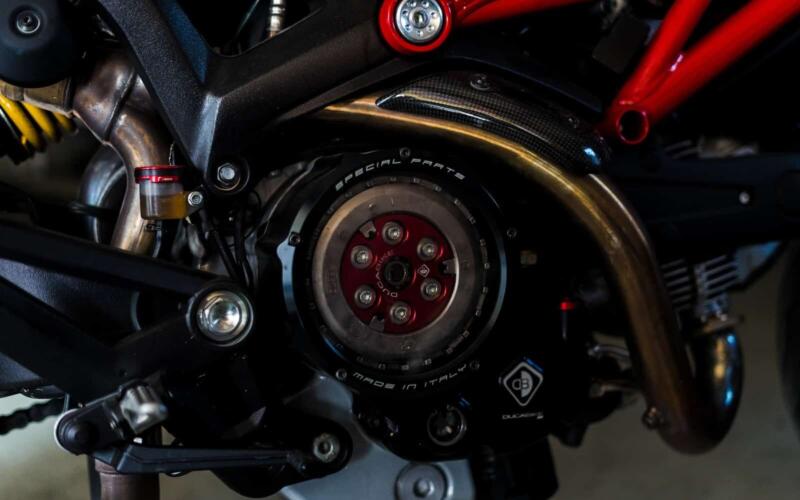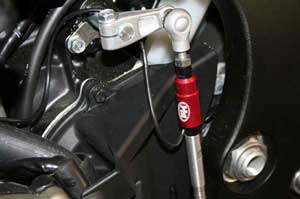I recently wrote an article on this website about how to replace a broken clutch cable on the roadside, and how to be prepared if you ever find yourself stranded without a clutch. Then I began to wonder if you would be completely stranded, or if you could somehow ride without using a clutch. So I did a little research and here’s what I found out.
So, can you shift gears on a motorcycle without using the clutch? Yes, you can. Motorcycle shifting without clutch is a technique used by many riders who want to minimize the time wasted between gears. It’s often used by riders who race motorcycles or those who want smoother, faster shifting. When done properly, it does no damage to your motorcycle’s transmission. However, the technique doesn’t work as well when downshifting, when shifting from first to second, or with certain types of motorcycles.
For clutchless shifting to the next gear, the shift lever can be used. The clutch lever does not have to be used for changing from first to second gear. A clutchless shift uses the gear teeth for engine braking. A functional clutch lever is exactly what you need for shifting gear. All the gears on a motorcycle can still work if the clutch cable snapped. To shift positions to second gear, use the clutch for a transmission slide.
How to Shift Without the Clutch

Clutchless shifting has everything to do with timing. There are only a couple of steps involved and with a little practice, you’ll become more and more smooth at it. Anytime there is load on the transmission, it’s not going to want to shift gears, so the trick is to eliminate that load on the gear sprockets. Once the load is gone, you can shift. Here’s how.
When you’re ready to shift, place your toe under the shifter lever and apply a slight amount of pressure. Not so much that it tries to shift gears; just take the slack out. Next, you will quickly roll off the throttle. When the throttle is all the way off, this will take pressure off the gear sprockets and allow your bike to shift into the next gear. The pressure you’re putting on the lever should be enough to make it shift. Lastly, roll back on the throttle and go.
Keep in mind that these steps take place in less than a second. Apply pressure to the lever, roll off the throttle, up shift, go. With a little bit of practice, you’ll begin to feel that sweet spot, and your foot will know exactly when to lift the lever. This technique works best if you are up shifting to any gear higher than 2nd gear, so it’s going to be much more difficult to shift from 1st to 2nd because you will have to bypass neutral. So, would this be a good method to use if you’re stranded with a broken clutch cable? Possibly. If you can get your bike into neutral and start out in 2nd gear – and pop it into 2nd gear without the clutch, then you have a fighting chance. It would be tricky, but not impossible.
How to Do a Clutchless Downshift
Downshifting without a clutch is much trickier, requires perfect timing and will take a little more practice to get it right. To downshift, you will need to blip the throttle just prior to stepping on the shifter lever. For those of you who don’t know, blipping the throttle means giving it a very short, rapid twist. This blip will increase the rpm of your engine so that it will match the rpm of the lower gear you’re about to shift into. Blip the throttle, change gears, all in one, quick, perfectly timed motion. If you get it wrong, your bike won’t shift and you’ll simply have to try again.
You will also need to practice the technique of blipping your throttle while squeezing the front brake lever smoothly and in a controlled fashion. This can be done by holding the throttle with the thumb and index fingers, while your other three fingers squeeze the brake lever. Another option, and one I prefer, is to apply the break with your first two fingers and blip the throttle with your thumb and other two fingers. The first few times I blipped the throttle while braking, I kept grabbing a handful of brake, but over time, my control got a lot better.
Will Clutchless Shifting Damage my Motorcycle?

Here’s where you will find differences of opinion. Some will tell you not to do it as there is no real reason for it unless you’re riding the track or drag racing and that you’re only inviting trouble if you do it. Trouble in the form of unnecessary wear and tear on your transmission. So, what’s the truth? Shifting without the clutch can damage your transmission if you do it wrong on a consistent basis. To make sure you’re doing it right, there are certain noises you should listen to. If you hear any kind of hard clunking while you shift, you’re not quite hitting the timing right. It means you’re probably shifting a bit soon. You need to shift right when the engine is at no throttle. If you hear any kind of grinding noises when you shift, you’re doing it wrong and this can really damage your gears.
Downshifting without the clutch creates a greater risk of damaging your transmission, this is true, and it takes a lot more practice to get it to spot on. Again, if you hear any kind of hard clunking, or gears grinding, you’re not doing it correctly and need to make some adjustment in your throttle timing or just go back to shifting with the clutch.
Clutchless shifting doesn’t work well with all motorcycles. They work best with sport bike and dirt bikes because these bikes run at a higher RPM and they have shorter gear boxes. This means there is a very short distance between gears in the transmission. The technique is more commonly used by sport bike riders who are taking their motorcycles to the track and want to shave a few tenths of a second off their lap times.
However, bikes with larger gear boxes and lower RPM’s, will have a hard time cooperating with you if you try to shift without the clutch and you run a higher risk of damaging your transmission.
Install a Quick Shifter

A quick shifter is an aftermarket kit that integrates with the ignition system on your motorcycle or with the fuel system depending on what type you get. In short, when you move the shifter lever, it will momentarily cut off the ignition or cut off the fuel supply. This will reduce the load on your gear box, allowing your bike to change gears when you lift the shifter. So, with a quick shifter, there is no need to roll off the throttle or use the clutch. All you need to do is stay on the throttle and shift.
Quick shifters are popular with riders who do track days and, while it will not make your bike faster or give you more horsepower, it will make shifting through the gears on a wide open straightaway much faster and smoother. Imagine riding at full throttle and not having to worry about releasing the throttle every time you want to shift. The quick shifter will do that for you. They are not just for riders who do track days or drag racing. Anyone who wants to accelerate quickly and smoothly when entering the freeway, or taking off on a clear, straight street would probably like it.
You can downshift with the quick shifter installed, but you will be using the same technique mentioned earlier, blip the throttle to match the rpm of the motorcycle gear. The quick shifter will not do that for you.
So, going back to my original question. Would I be able to ride to the nearest town, or home, if my clutch cable snaps? Yes, I think I can. Although it would be a real pain in the neck to get it started from a dead stop, and I sure hope I don’t hit any red lights.







